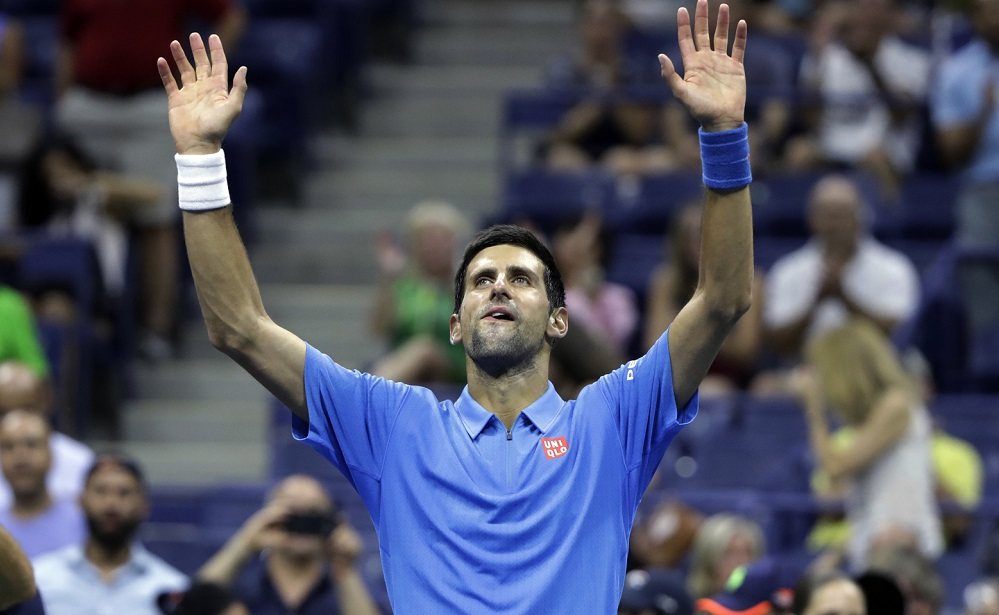
Novak Djokovic had extra time to rest at the 2016 US Open, and even having his elbow worked on, the world’s top-rated tennis star took out Kyle Edmund in three sets.
Djokovic was not interested in discussing in any detail why he needed a trainer to work on his right elbow during an otherwise matter-of-fact 6-2, 6-1, 6-4 victory over Kyle Edmund on Sunday night that put the defending champion in the U.S. Open quarterfinals for the 10th consecutive year.
Much as he did after having that same arm treated on Day 1 of the tournament – the last time he was forced to play a full match – Djokovic deflected questions about the elbow at his post-match news conference.
At one point, he said: “It was good. Everything was fine.”
[pdf-embedder url=”https://movietvtechgeeks.com/wp-content/uploads/2016/09/2016-us-open-mens-singles-part-quarter-finals.pdf” title=”2016 us open mens singles part quarter finals”]
Djokovic said he doesn’t have pain in the elbow. Later, when a reporter asked why he asked for the medical visit, Djokovic said with a smile, “I needed a little bit of a massage.”
He had competed for a total of only 31 minutes over the preceding five days because of injuries to his opponents in the second and third rounds.
“Obviously, I haven’t played too much tennis. So I’m really glad to be back,” Djokovic said in an on-court interview. “I thought I came out, really, from the blocks very good, playing with a high intensity.”
That he did. Yet while Djokovic looked quite good for the first two sets against the 84th-ranked Edmund, and again at the very end, there was that interlude that included the trip from the trainer at 2-1 in the last set.
That came right after Djokovic got broken for the first time in the match and was part of a stretch of three games in a row for Edmund.
“I’m feeling very good, to be honest. I really wanted to start the match well today,” Djokovic said, “because I didn’t have much time on the court overall before the fourth round, and considering I had some struggles before the tournament.”
His left wrist had been bothering him since early August, so Djokovic arrived in New York without much recent match play, having lost in the first round of the Rio Olympics and pulled out of a hard-court tuneup tournament.
Until the issue with the right arm resurfaced in the third set against Edmund, Djokovic appeared rather rested and ready.
After about 75 minutes Djokovic led by two sets and a break. He produced various bits of magic along the way: a jumping, head-fake drop shot at an impossible angle; a stretching angled cross-court backhand pass that drew an errant volley from Edmund; a body-contorting defense-to-offense forehand that drew a roar from spectators.
“I made Kyle work for each point,” said Djokovic, whose quarterfinal opponent is No. 9 Jo-Wilfried Tsonga, the man he beat in the 2008 Australian Open final for the first of his 12 major championships. “I wanted to move him around the court.”
Djokovic even cracked a smile after one effortless exchange in which he ran Edmund this way and that before dropping a backhand winner right near the baseline early in the third set.
And yet it was in that same game that Edmund began his mini-run. At the ensuing changeover, Djokovic was visited by the trainer, who pressed a thumb just above the back of the player’s right elbow, while manipulating that joint in various ways. Edmund broke for a second consecutive time to suddenly lead 3-2 as Djokovic’s coach, Boris Becker, looked on from the stands, grim-faced.
That, though, was that. Djokovic broke back to 3-all, and after a trade of service holds, he took the last two games. He has reached at least the quarterfinals at 29 of the past 30 Grand Slam tournaments – the exception was his loss in the third round of Wimbledon in June against Sam Querrey.


